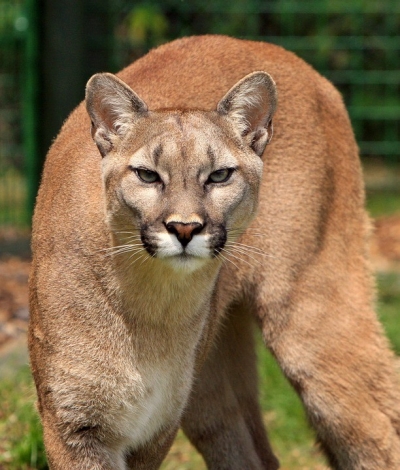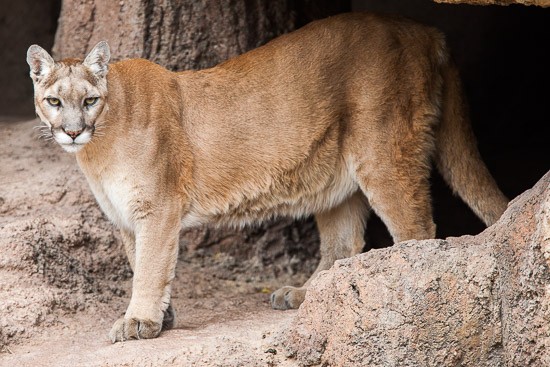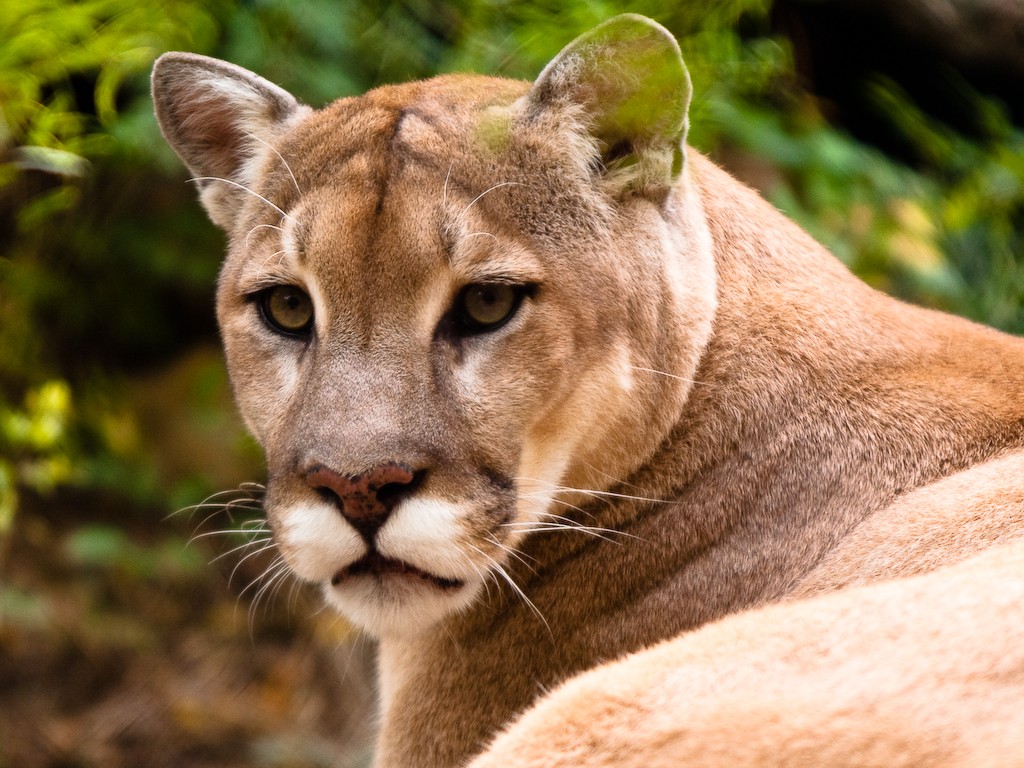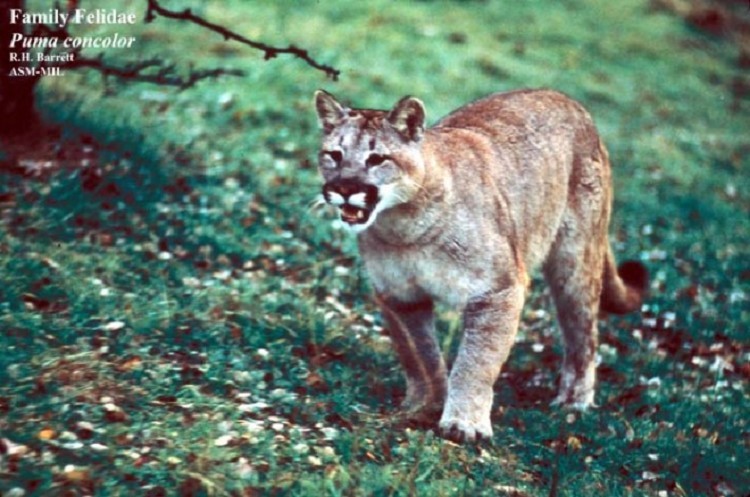Cougars, Puma concolor,
The cougar (Puma concolor), also known as mountain lion, panther, painter, puma, and catamount, is the largest feline animal in North America.
There haven’t been any cougars established in Tennessee since the early 1900s. Similar to Tennessee’s wild elk and buffalo, the cougar was extirpated from the state around the early 1900s due to overhunting and habitat loss. However, the cougar may be coming back to Tennessee, there have been some confirmed sightings in Tennessee in recent years.
The cougar belongs to the family Felidae (cat family) which is in the order Carnivora. This powerful predator ranges from 5 to 8 ½ feet in total length and weighs from 70 to 250 pounds, with males being bigger than females.
Adults are large sleek cats with small heads. Their ears are black on the upper side and are small and rounded with no tufts of hair. The muzzle is white on the end and black where it joins the head.
Cougars have a long heavy cylindrical tail ranging in length from 20 to 30 inches, with the last couple of inches blackish in color. Claws are retractable and are very seldom part of a track.
Cougar fur is generally a solid tan color on the upper parts with white undersides. Slight variations can make the solid brown cat have a reddish, yellowish, or grayish tinge.
No black color phase (termed melanistic) of a cougar has ever been documented. There is, however, documentation of melanistic jaguars (Panthera onca) that live in Mexico and south to northern Argentina, as well as melanistic leopards (Panthera pardus) in Africa.
The bobcat is the only other animal belonging to the cat (Felidae) family that can be found in Tennessee. Bobcats differ from cougars in their size, coloration, and tail length. They are much smaller than cougars, ranging in weight from 10 to 40 pounds, whereas a cougar starts at 70 pounds. Their coat is not uniform in color like the cougar’s but is marked with black spots and streaks. They also have pointed ears with hair tufts, unlike the cougar. The bobcat’s tail appears “bobbed”, hence the animal’s name, and is typically 3 to 8 inches in length, which is very short in comparison with the tail of a cougar.

Cougar Status in Tennessee
Because Tennessee law protects all animals for which no hunting season is proclaimed, the cougar is protected in Tennessee. It is illegal to kill a cougar in Tennessee except in the case of an imminent threat to life and injury.
Also, if a landowner is experiencing property damage caused by wildlife, that landowner has the right to protect his/her property.
TWRA has never, nor does it have any plans to stock or otherwise physically encourage the establishment of a cougar population in Tennessee.
TWRA plans to monitor the natural expansion of the cougar from the western US as it pertains to Tennessee.
Cougar Subspecies in North America
There are three subspecies of cougar relevant in North America.
The Western Cougar is well established in the Western USA, Western Canada, and throughout Mexico. This subspecies is likely recolonizing and expanding its range in the Midwest and is likely the subspecies that is the subject of Tennessee cougar sightings.
The Eastern Cougar, once ranging in all of the U.S. east of the Mississippi River, is now officially extinct, with the vast majority of the population wiped out by the early 1900s. Because the federal Endangered Species Act does not protect extinct species, the Eastern Cougar subspecies was officially removed from the federal endangered species list this year (2015).
The Florida Panther, residing on the southern tip of Florida, is the only breeding population of cougar east of the Mississippi River. With a population estimate of 100-180 individuals, this subspecies is on the federal endangered species list. The occasional dispersing male has made his way into Georgia and parts of Alabama.
Cougar Encounters
Cougars are shy, nocturnal, solitary, secretive animals with large home ranges. Because of their behavioral patterns, the likelihood of encountering a cougar is extremely slim, even in areas with established populations.
To show how rare a cougar attack is, compare the number of human fatalities resulting from cougar attacks to those resulting from other hazards from animals or nature. In the 100 years between 1890 to 1990, in the U.S. and Canada, only 10 humans died due to cougar attacks.
1 Every year in the U.S., an average of 26 human deaths are the result of dog attacks, 3 deaths from bear attacks, 12 deaths from rattlesnake bites, 40 deaths from bee stings, and 90 deaths from lightning strikes. Also, considering there have been no confirmed sightings of a cougar between the years 1900 and 2015 in Tennessee, the chances of a cougar encounter are even smaller.
Even if the chances of encountering a cougar are minuscule, it doesn’t hurt to know what to do!
Cougars are large predatory carnivores, and if you see one, it might be deciding whether or not you’d be an easy meal. Never run, but instead make yourself threatening by standing tall, waving your arms, throwing objects, and yelling.
Don’t turn away, but back away slowly, and towards shelters like a car or house if possible.
Pepper spray may also be effective. If you’re with a group of people, gather together.
Dogs and children have a tendency to run, and they are more vulnerable than you, so pick them up so they don’t become a target.
If the animal attacks, fight back! Do not play dead. Report the encounter to local authorities and TWRA as soon as possible.
Range
The cougar occupies the most extensive range of any New World terrestrial mammal, from the Canadian Yukon to the southern tip of South America.
In the United States, cougars inhabit the western region and extend eastward as far as the western edge of the Dakotas, Nebraska, and close to the eastern borders of Colorado and Texas.
A study published in the Journal of Wildlife Management in 2012 compiled confirmed locations of cougars collected outside of their established range during 1990-2008.
The results of the study suggest that the cougar is recolonizing the Midwest with a range expansion eastward. It is well documented that cougars travel hundreds of miles in search of new territory.
The recent confirmed sightings in Tennessee could be a result of this range expansion and long exploratory treks by transient cougars.
This expansion does not equate to population establishment. Population establishment only occurs where reproducing females are documented.
Considering that there are large expanses between Tennessee and the established populations, it will likely be a long time before cougars make their home here.
Confirmed Sightings
Since September of 2015, there have been a few confirmed sightings of cougars in Tennessee. These are listed below and are displayed in the Tennessee Confirmed Cougar Sightings Map. When more confirmed sightings occur, they will be added accordingly.
| Date | County | Evidence |
|---|---|---|
| 9/20/2015 | Obion | Trail camera photo submitted by a landowner |
| 9/26/2015
|
Carroll
|
Hair sample was submitted by a hunter; DNA analysis indicated a female with genetics similar to cougars in South Dakota |
| 11/11/2015 | Humphreys | Trail camera photo submitted by a landowner |
| 11/24/2015 | Humphreys | Trail camera video and photos submitted by a landowner |
| 12/11/2015 | Humphreys | Trail camera photo submitted by a landowner |
| 12/18/2015 | Humphreys | Trail camera photo submitted by a landowner |
| 02/04/2016 | Humphreys | Trail Camera photos submitted by a landowner |
| 08/03/2016 | Humphreys | Trail camera photo submitted by a landowner |
| 09/04/2016 | Wayne | Trail camera photo submitted by a landowner |
| 09/04/2016 | Wayne | Trail camera photo submitted by a landowner |
TWRA receives many photos and reports of cougars, but until 2015 the photos were not confirmable. What does it take to become an officially confirmed sighting?
- The photo must be of a cougar. Many photos turn out to be other animals caught in a position in which they look like a cougar. Often perception in a photo can be distorted, making house cats and bobcats appear cougar like. Coyotes and large dogs are also often mistaken for cougars. Also, many trail camera photos are taken at night and are too unclear to make out the details to really know what kind of animal is in the photo.
- The photo must be authentic. It boggles the mind the number of cougar hoaxes that are out there. Many times a photo of a cougar from another state is touted as being from Tennessee. Other times, an image of a cougar has been “photoshopped” on to a photo of Tennessee landscape. Photographic evidence must be examined to rule out these possibilities. Often, the physical site that is represented in the photo is examined by TWRA staff members.
There are many steps in the confirmation process. Just because the landscape in the photo has been confirmed as real, doesn’t mean the sighting itself has been confirmed. There is more examination to be done.
Hair, tracks, and scat samples can be analyzed as evidence of a cougar sighting. Sign left behind such as kill sites and caches, drag marks, and scrapes can also be useful. Cougar tracks are round and are 3-4 inches long and 3-4.5 inches wide. When photographing suspected cougar tracks it is helpful to place a ruler or object such as a coin to enable size judgment. Large dog tracks are often mistaken for cougar tracks. Like a dog, the paw has four toes and a pad. Unlike the dog, the toes are teardrop-shaped and the pad at the opposite end of the paw has three lobes, while the dog’s pad has two lobes. Bears have 5 toes and a pad.
A detailed explanation of the confirmation process of the first confirmed cougar sighting is available here.




